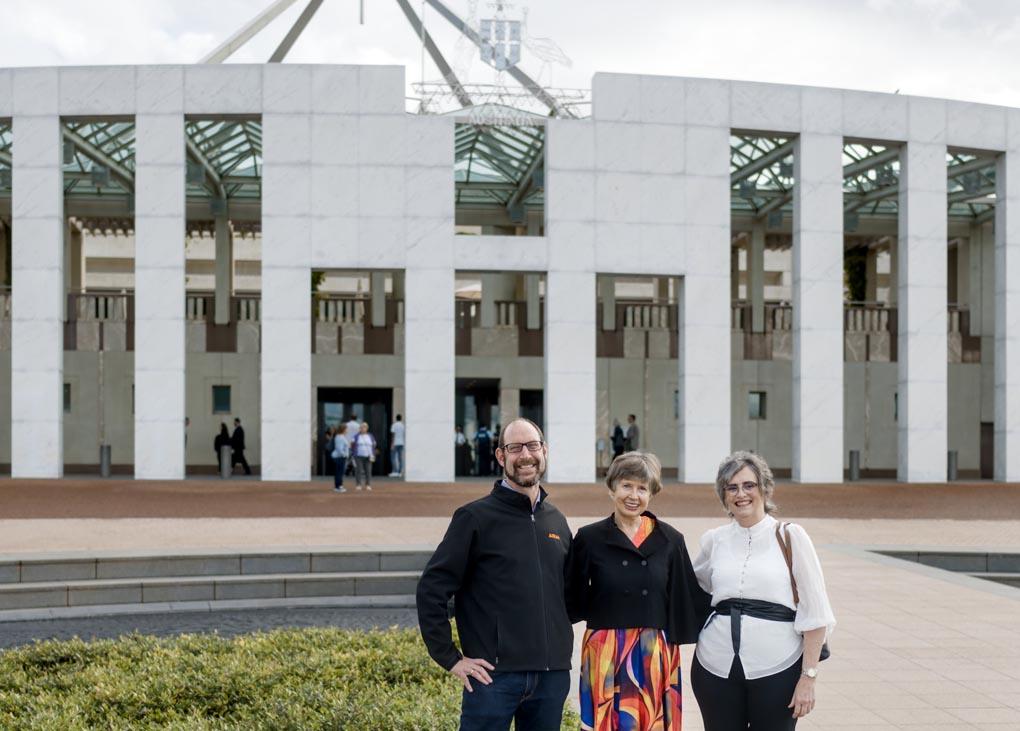More than 50 industry leaders advocating for better indoor air quality have gathered in Canberra for a Clean Indoor Air Forum.
Organised by the Burnet Institute, the Australian Academy of Sciences and CSIRO, the event featured leaders from engineering, science, medicine, public health, politics, and academia, as well as people whose lives have been dramatically affected by breathing poor quality air. Together, they shared progress on clean indoor air activities, identified synergies and potential for joint action, and explored how to best support knowledge exchange and policy change for clean indoor air.
“AIRAH was pleased to be at the event as a peak body representing engineers and allied professionals specialising in ventilation systems,” says AIRAH’s Advocacy and Policy Manager Mark Vender, who along with Dr Claire Bird, Associate Director of the AIRAH IAQ STG, attended the event.
Although the conversation covered earlier talking points about preventing airborne transmissible disease, important updates were shared and new themes emerged.
Indoor air quality standards still the goal
Vender says the stakeholders remain united in their call for an operational indoor air quality standard in Australia.
“We have design standards, of course, and AIRAH’s Special Technical Groups have provided important feedback on the revised version of AS 1668.2 earlier this year. But we also need minimum acceptable conditions for indoor spaces during their operation.”
During the evening session, held at Parliament House, QUT’s Professor Lidia Morawska indicated that a soon-to-be-published paper will lay out the basis for an operational IAQ standard, which could be used in an Australian Standard.
IAQ: bigger than COVID
Although reducing the spread of SARS-CoV-2 and other airborne infectious diseases remains a focus, many other vulnerable groups are now calling for better indoor air. Concerned parties include the Asthma Council of Australia and the Australian Asthma Association, whose members suffer from well-established symptoms related to air quality.
“There are some pretty amazing advocates in IAQ who have developed organisations because they were personally affected by its failure,” says Bird. “We heard from people with long COVID, asthma, chronic fatigue syndrome and lung issues, which they attribute to poor management of our indoor air.
“It was also enlightening to see provision of acceptable IAQ for all framed not just as a health issue, but as an equity and inclusion issue. And it’s true – as one attendee pointed out, we require public spaces to have ramps for people with mobility issues, but we don’t require them to have minimum IAQ levels to protect vulnerable members of the public from airborne pathogens.”
Areas for further work
Bird says some aspects of IAQ require more attention, and a better understanding.
“The IAQ risks that are currently harder to quantify, or do not have clear thresholds were notably absent from the conversation,” she says. “The focus for now is on easy-to-measure pollutants, often in real time, to provide a solid starting point. The concept of diluting all pollutants at the same time by ventilation has won ground.
“Some attendees spoke about the importance of avoiding dampness in buildings, and the unintended ingress of outdoor bioaerosols such as fungi, bacteria and pollen that exacerbate asthma and can cause long-term chronic diseases if we don’t get the balance right. There was also a strong focus on particulate pollutants released as a result of burning. Bushfires were a notable target, as were wood stoves in people’s homes.”
And Bird says there are other issues that we are only beginning to understand.
“Semi-volatile organic compounds, such as PFAS or phthalates, come from a range of indoor sources and last indefinitely,” she says.
“There’s also research going on into airborne micro and nano-plastics, and antimicrobial resistance factors. These will need consideration in the future.”
The risk of fragmentation
Among the organisations present, many have developed frameworks, educational resources and awareness campaigns. Although this reflects a growing interest in the subject of IAQ, it also presents a risk, says Vender.
“It can become competitive rather than collaborative. In the end, the public is not sure which resources they should use.
“This underscores the importance of the government disseminating education materials and establishing frameworks for monitoring IAQ. As a trusted, official source, they have the power to get the public on board and educate them.”
Decarbonisation – an opportunity
Participants discussed the nexus between energy efficiency and indoor air quality. In the main, the attendees said it was possible to have both.
“There are a number of projects investigating how we can improve indoor air quality while making buildings more energy efficient,” says Bird.
“In fact, our members tell us that decarbonisation is an opportunity to improve IAQ. Over the next decade or so, we will be retrofitting and renovating buildings like never before. It’s the perfect time to develop and implement smart energy efficiency interventions that will also lift IAQ.”
The world is moving on IAQ – what about Australia?
The final session of the day saw video presentations from the UK, France, the US, and New Zealand, talking about successful initiatives. Representatives from the World Health Organization and the UN also spoke.
Vender says that compared to these countries, Australia is falling behind on IAQ.
“We seem to be stuck in Australia, at many different levels,” he says. “We heard from Boston, where they installed thousands of IAQ monitors in schools and shared the information online. Here in Australia, the stories were about pushback from schools who are unwilling to monitor IAQ, or from departments of education who refuse to disclose what measures they are taking unless forced to via freedom of information requests.
“The UN Special Rapporteur for Human Rights, Dr David Boyd, pointed out that although Australia signed the UN resolution declaring access to a clean, healthy and sustainable environment as a universal human right, we are not taking any clear action on indoor air.
“Whether it is acted on by the department for health, environment, or workplace safety, government needs to seize this opportunity to future-proof our buildings in a rapidly changing climate.
“AIRAH continues to advocate for operational air quality standards in Australia, and government-backed public education campaigns to raise awareness about the importance of our air.”
Speakers from the Clean Indoor Air Forum will also be appearing at AIRAH’s IAQ Conference, on July 15–16, 2024.
 Nick Johns-Wickberg
Nick Johns-Wickberg


Leave a Reply